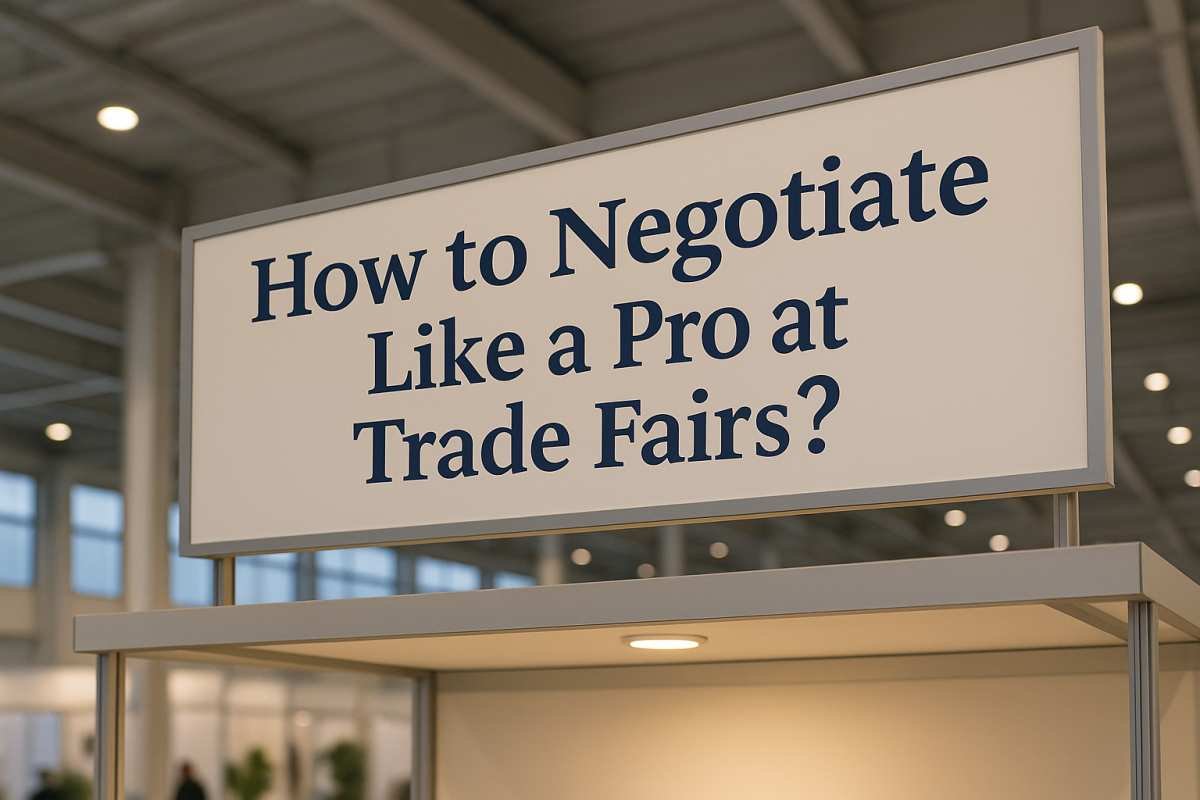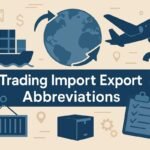How to Negotiate Like a Pro at Trade Fairs? – Tactics to Use and Questions to Ask
Walking a fair in Guangzhou, Milan, or Dubai is intense, hundreds of booths, smiles, and samples. Pros win not by haggling harder, but by asking smarter questions that reveal costs, capacity, and risk. Use these scripts to sound experienced, earn respect, and secure better prices, terms, and quality.
1) Lead with credibility (not price)
Open strong so suppliers treat you like a serious buyer.
“We supply [market/segment] with monthly volumes. I’m comparing 3-4 factories today for a Q4 launch.”
“I need [spec/model] with [certs] for [country]. Can we review pricing by MOQ (Minimum Order Quantity) and step breaks?”
2) Replace rookie questions with pro questions
❌ Don’t ask: “How much?”
✅ Say: “What’s your wholesale price at MOQ? And what are the price breaks at 2× and 5× MOQ?”
❌ Don’t ask: “When can I get my order?”
✅ Say: “What’s your sample time and production lead time? Do you offer priority slots in peak season?”
❌ Don’t ask: “Different colours?”
✅ Say: “Can you mix colours/styles per order? What’s the extra cost per variation?”
Add these pro checks:
“What’s your defect rate last quarter and replacement policy?”
“Which EU/US clients do you serve and which certifications (CE, RoHS, REACH, ISO) are current?”
“Factory visit or live production video available?”
“Can we start with a trial order and lock a scale-up price if QC passes?”
“Who handles logistics? Your forwarder or mine? Quote EXW/FOB/CIF so I can compare.”
“For long-term partners, what payment terms do you offer (30/70, Net 30, OA with insurance)?”
3) Price & terms script – Scripts, Rationale, and Variations
You’re not just asking for a discount, you’re trading value: credible volume (price breaks), flexible timing (off-peak capacity), clear QC (AQL 2.5/4.0), and secure payment terms (Net 30 with trade insurance). This signals a professional buyer and lets the factory justify a sharper price without losing face.
Core Script (copy/paste)
“At MOQ 1,000, I see $4.20 FOB. If we confirm a pilot of 1,000 this month with a target of 5,000/quarter, can you do $3.85 and include color-mix at no extra cost?
If AQL (Acceptable Quality Limit) 2.5/4.0 passes and delivery meets 30 days, we sign a 12-month supply with Net 30 via trade insurance.”
Why include each element:
- Price at MOQ: anchors negotiation at a specific, comparable tier.
- Volume pathway (5k/quarter): proves scale so the supplier can model margin recovery.
- Value adds (color-mix): non-price concessions that matter to you, low cost to them.
- AQL & 30-day lead time: ties price to measurable performance.
- Net 30 + insurance: safer cash-flow for you, risk-mitigated for them.
Variant A: EXW/FOB/CIF Comparison (landed-cost clarity)
“Please quote EXW, FOB, and CIF [destination port] for MOQ 1,000, 2× MOQ, and 5× MOQ.
If we target FOB $3.85 at MOQ, we can confirm a pilot 1,000 now and schedule 5,000/quarter on the same structure. Include GW/NW, carton size, and CBM for freight optimization.”
Use strong buyer keywords: INCOTERMS EXW/FOB/CIF, landed cost, carton CBM, GW/NW.
Variant B: “I’m not in a rush” (use time as a lever)
“We’re flexible on ETD. If we shift to your off-peak window or accept +2 weeks lead time, what best price can you offer at MOQ and 2× MOQ? We’ll still require AQL 2.5/4.0 and Net 30 with insurance.”
What to lock: latest acceptable ship date, inspection timing, and a written price tied to the flexible window.
Variant C: Terms over Discount (cash-flow first)
“Keep FOB $4.05 at MOQ but offer Net 30 (insured) and free color-mix. If our PSI passes AQL 2.5/4.0 and lead time holds, we scale to 5,000/quarter with a $3.90 target.”
Why: Sometimes better terms > small unit discount.
Variant D: Compliance-heavy categories (electronics, toys, cosmetics)
“Confirm CE/RoHS/REACH/FCC/UL (as applicable) with current test reports and DoC.
Price FOB at MOQ/2×/5×, include tooling if needed. Passing AQL 2.5/4.0 and document verification → 12-month framework on Net 30 (insured).”
Counter-Offer Ladder (use stepwise movement)
- Step 1: $4.20 → $3.90 FOB + free color-mix + priority slot next order
- Step 2: If no: keep $3.90 but swap priority for extra 1% spare parts
- Step 3: If still no: $3.95 + Net 30 + PSI at supplier’s cost if fail
Keep a concession log: each ask pairs with a give (price, timing, terms, extras).
Price-Break Matrix (paste this request)
“Please provide a price matrix with INCOTERM and lead time per tier:”
| Qty Tier | EXW | FOB | CIF [Port] | Lead Time | Notes |
|---|---|---|---|---|---|
| MOQ (1,000) | $ | $ | $ | days | Color-mix? |
| 2× MOQ (2,000) | $ | $ | $ | days | Tooling? |
| 5× MOQ (5,000) | $ | $ | $ | days | Off-peak? |
4) Quality control you should always discuss
- Specs & samples: Golden sample signed with photos and measurements.
- AQL plan: “Final inspection at AQL 2.5/4.0; pre-shipment report required.”
- Defect handling: “Under 1% DOA, replace in next shipment; above 1%, immediate replacement or credit.”
- Packaging: Drop-test standard, barcode/labeling for your market.
- Certificates: Request PDFs with lab names and expiry dates; verify sample against cert.
5) Logistics and hidden-cost traps
- Always collect EXW, FOB, and CIF quotes to see where the margin shifts.
- Confirm carton sizes, GW/NW, and palletization, this drives freight class and cost.
- Ask about peak-season surcharges, port congestion, and holiday closures.
6) Relationship first, numbers second
- Trust beats hard bargaining in most markets.
- Be polite, learn a name, take a card, photograph the booth & product tag.
- Summarize next steps in writing the same day (WhatsApp/Email).
- Keep one contact per factory; too many threads = mistakes.
7) Follow-up email template
Subject: [Product] – Samples, Pricing Breaks & Lead Time
“Thanks for your time at [Fair Name].
Please confirm: MOQ, price breaks (1k/5k/10k), sample time, production lead time, certifications, AQL, payment terms, INCOTERM.
Attach pro-forma for trial order [qty/date]. Photos of the golden sample appreciated.”
PO clause (QC):
“Shipment subject to AQL 2.5/4.0 final inspection. Non-conformity triggers replacement/credit. Documents required: CI, PL, B/L or AWB, COO, DoC, current test reports.”
8) Common mistakes (avoid)
- Only chasing lowest price (often raises QC and delay risk).
- No written AQL → disputes later.
- Forgetting price breaks, tooling fees, color-mix rules.
- Skipping cert verification → customs problems.
Quick Checklist (print for the fair)
- MOQ + price breaks (1×/2×/5×)
- Lead time (sample / mass)
- AQL + replacement policy
- Certificates & expiry (CE/RoHS/REACH/ISO/UL/FCC)
- INCOTERM (EXW/FOB/CIF/DAP/DDP)
- Packaging data (GW/NW, carton sizes, CBM)
- Payment terms & trial order (T/T 30/70, L/C, OA)
- Photos of booth + samples, product, labels
- Same-day summary email + request PI (Purchase Invoice)
Trading Import Export Abbreviations: Essential Glossary / Acronyms
Use Time as a Negotiation Lever (Don’t Rush)
If your launch date is flexible, trade speed for price. Factories discount when they can fill idle capacity or push work into off-peak windows.
Why it works: you solve their scheduling problem (smooth the line), so they share margin.
Booth script:
“We’re flexible on ETD. If we shift production to your low-season window or accept a +2 weeks lead time, what’s the best price at MOQ and 2× MOQ?”
Email line:
“We can accept ETD ±2–3 weeks to help with capacity. Please confirm your off-peak slot and the discount you can offer with that timing.”
What to lock in (to stay safe):
- A latest-acceptable ship date (not open-ended).
- A price tied to the flexible slot (write it into the PI/PO).
- A milestone plan (deposit date, pre-production sample sign-off, pre-shipment inspection date).
- A penalty or air-freight share if the supplier misses the extended window.
Rule of thumb: Flexibility can unlock extras, unit price reductions, free color/style mix, priority slot for the next order, or extended warranty. Ask for two concessions, settle on one.
FAQ
Q1: What’s a good first order size?
A trial order at MOQ or slightly above, enough to validate QC and logistics.
Q2: Is discount or terms better?
Often better terms (Net 30/Insured OA) beat a small discount for cash flow.
Q3: How do I compare suppliers fairly?
Normalize quotes to the same INCOTERM, AQL, packaging, and lead time.
Q4: Do I need third-party inspection?
Yes, book pre-shipment AQL inspection; the fee is cheap insurance vs. a bad batch.
What to book (pick one or combine):
- DUPRO / During Production (20–60% complete): catches early issues before they multiply.
- PSI / Pre-Shipment Inspection (≥80% finished & packed): verifies AQL 2.5/4.0, labeling, packaging, and quantity before payment/shipment.
- CLS / Container Loading Supervision: confirms correct SKUs/quantities and proper loading to avoid transit damage.
- Lab tests / Certificate checks (as needed): confirm CE/RoHS/REACH/FCC/UL claims match your exact spec.
What to send the inspector:
- Signed golden sample photos & measurements
- Spec sheet + packaging/labeling requirements (UPC/EAN, warnings, language)
- AQL plan (e.g., 2.5 major / 4.0 minor) and defect examples
- PO/PI with INCOTERM, ETD/ETA, and contact at factory
- Cost & timing: Usually a few hundred per visit, scheduled 3–5 days before planned shipment so there’s time to rework if needed.
Pass/Fail clause (paste in PO):
“Shipment contingent on PSI pass at AQL 2.5/4.0. Failures trigger rework + re-inspection at supplier’s cost or credit/replacement.”
Q5: Can I get a better price if I’m not in a rush?
A: Often, yes. If you accept a longer lead time or schedule into the supplier’s off-peak, they can optimize labor and materials, and may pass along a meaningful discount or add free value (color-mix, spare parts, better terms). Use this line:
“We can ship later to fit your capacity. What discount or added value can you offer for off-peak production?”
Comprehensive Business Startup Checklist: From Idea to Launch + Excel and Word Free Download







